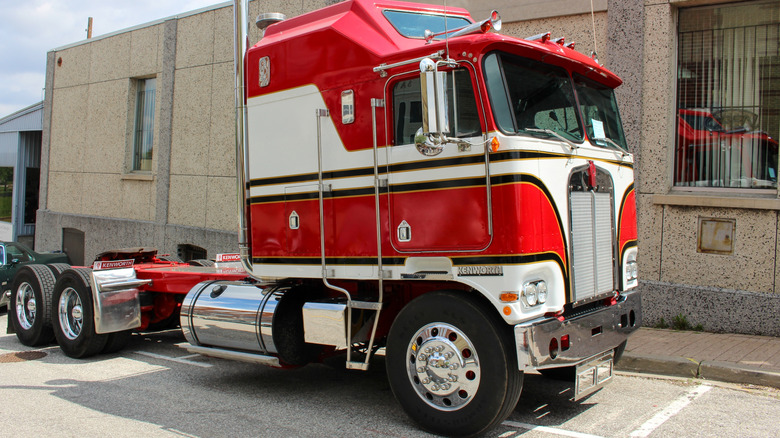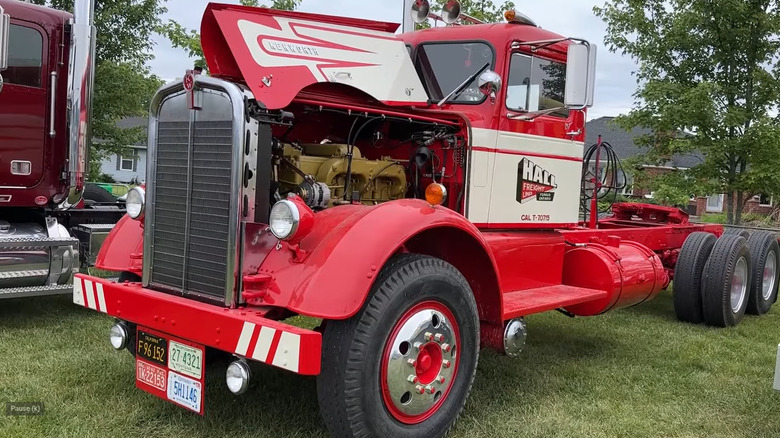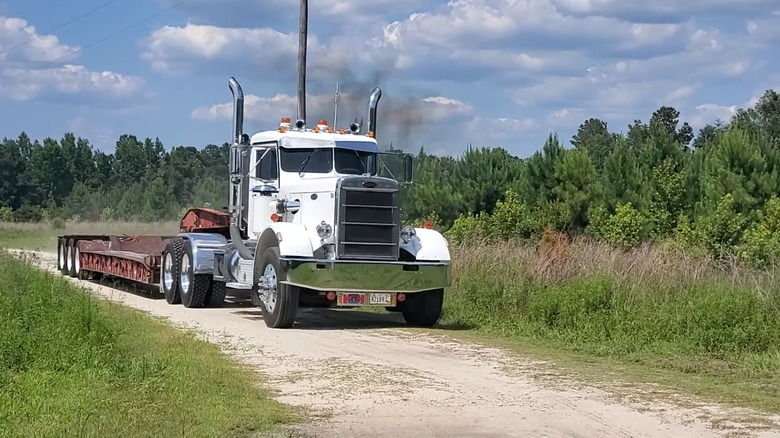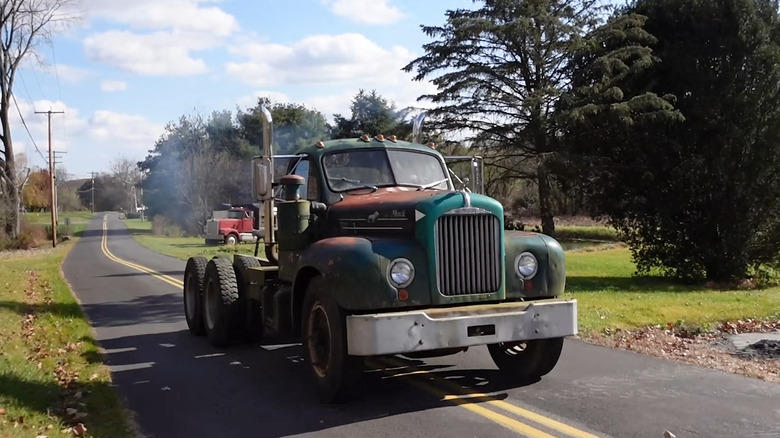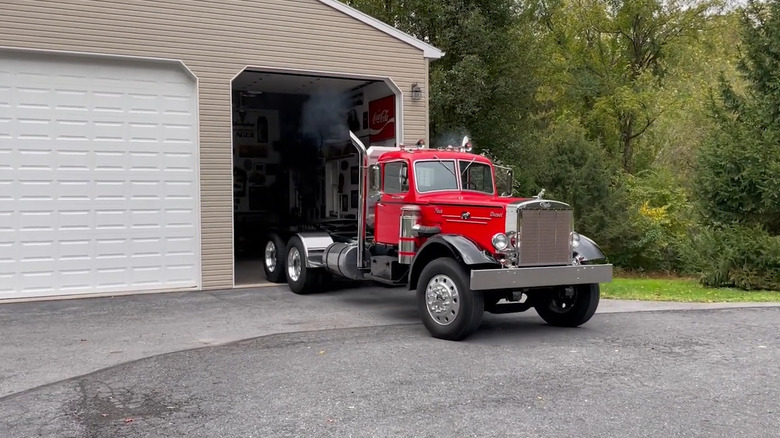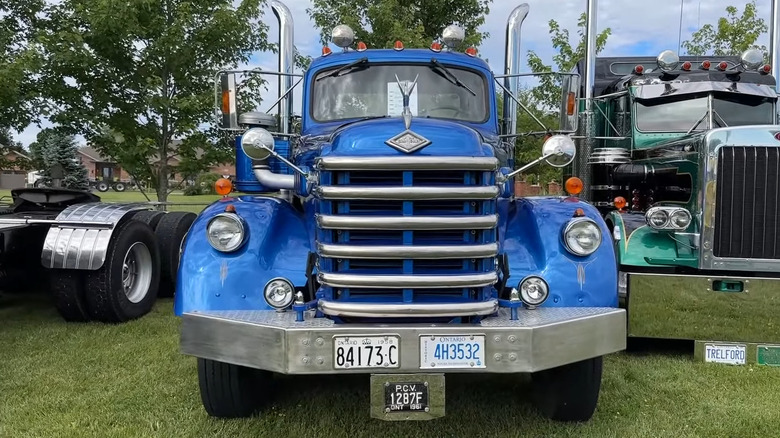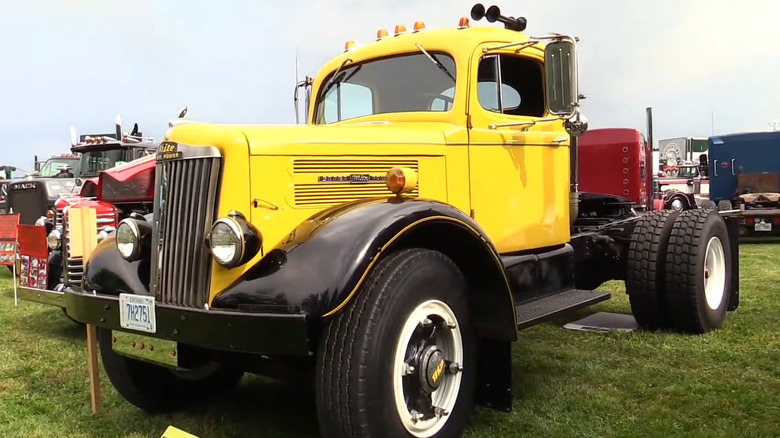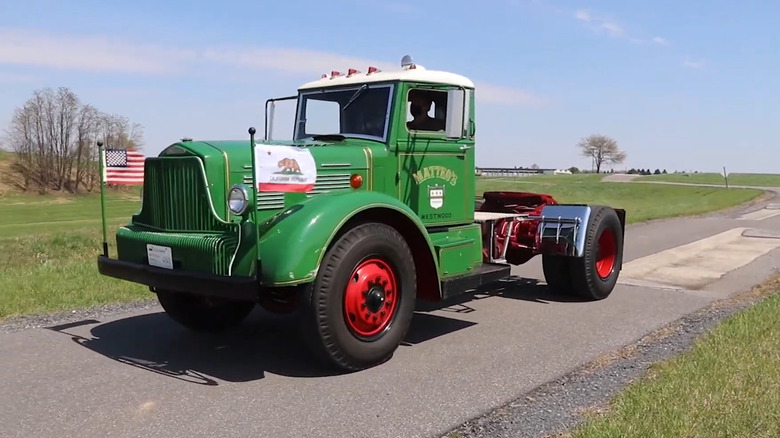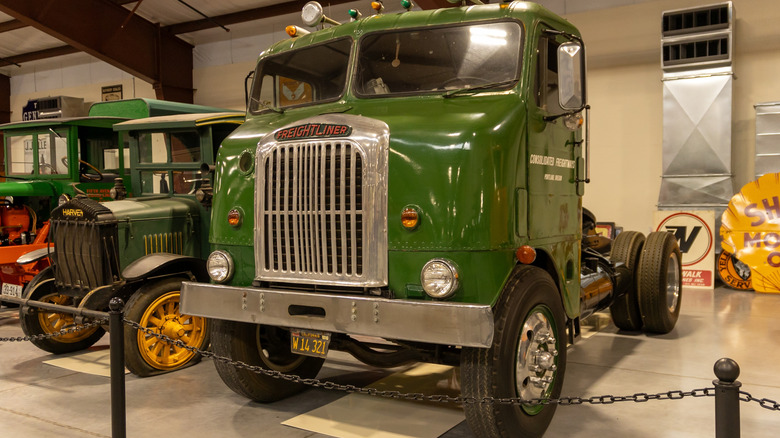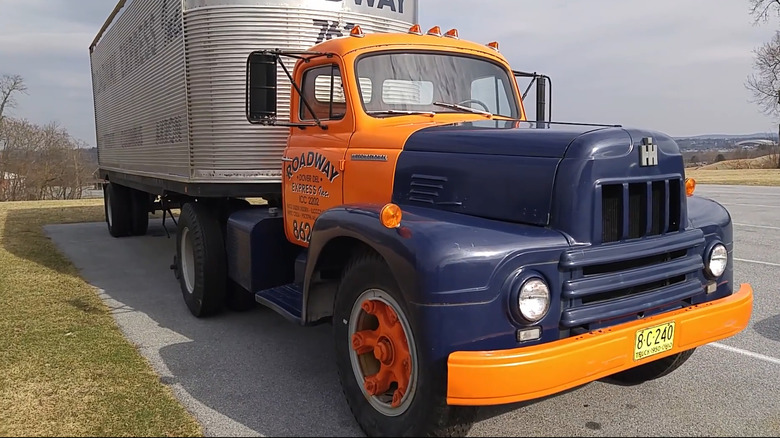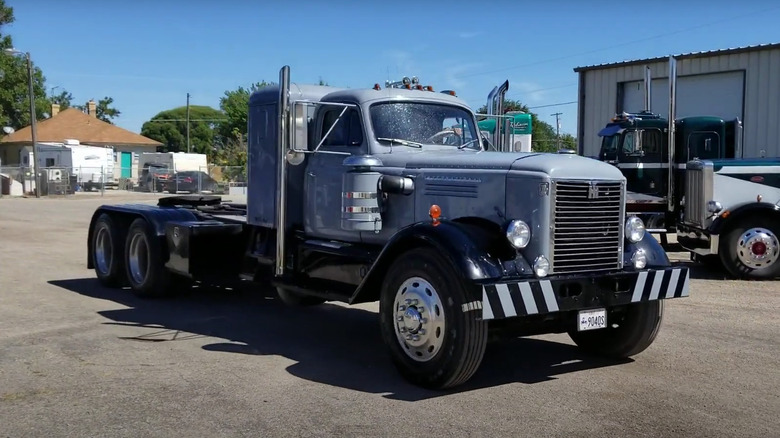13 Of The Best-Looking Semi Trucks From The 1950s
Semi trucks, though they get little recognition, or even respect, for that matter, are holding America together. These rigs, often called 18-wheelers, can last millions of miles, and are concentrated into just a few, very popular truck brands across the country. While we have some good-looking semi-trucks today, with people arguing over whether the Kenworth T680 or the Peterbilt 579 comes out on top, modern designs cannot hold a candle to those of days gone by, for the 1950s were the golden age of semi-truck design.
The post-war years were when American truck makers truly hit their stride, building vehicles that would look cool even half a century later. With hand-formed aluminum bodies, multiple tall, vertical-stack exhaust systems, and paint schemes that caught the eye from a mile out, the 1950s had it all. Today, many of these examples will fetch over six figures at sale. Here are 13 of the most stunning semi trucks from the 1950s.
1953 Kenworth 524
The Kenworth 524 hit its stride in 1953, just a couple of years after its launch. It came with a Cummins supercharged engine (called the NHRS) that would produce 275 hp and between 700 and 800 lb-ft of torque. This beastly powerplant -– for the time, at any rate -– would be paired to a 15-speed transmission from Spicer, which made it usable in all sorts of situations. As things stood, the 524 gained popularity in various off-road use-cases, such as logging – things that we would call severe duty in the industry today.
Other uses for the 524 included a special 6x4 setup that was intended for export and was used by the mines in Peru to haul ore from place to place. Notably, 1951 was also the year that marked the 10,000th Kenworth to roll off the assembly line, and in 1952, the company would break its record by producing more than 1,000 units in a year.
Design-wise, the 524 was perfection with the cab mounted on top of the engine; known as a cab over engine, or COE for short. The proportions were also quite pleasing to the eye, with a flat-front long hood, rising into a near-vertical windscreen, making it a great sight to see on the road.
1957 Peterbilt 351
Peterbilt came out with the gorgeous 351 in 1954. The 1957 model pictured above shows off its long butterfly hood with a huge flat-front radiator grille, massive bumpers, and extremely large fenders — it was also a COE design, but wider than the preceding conventional trucks. On top of that, there was chrome everywhere and on everything — the grille, the front and rear bumpers, on the wheels, exhaust stacks, fuel tanks, on all the filters, and everywhere else. The placement of the headlights was similar to the Kenworth, being mounted on the walls of the hood, between the space left by the fender.
Power for this generation 351 came from a six-cylinder Cummins unit that produced around 275 hp while being paired with a 10-speed transmission. There was also the option for buyers to get their Peterbilt 351 with a sleeper cab as well as day cabs, which was a trend that was just beginning to get traction in the industry. Today, if and when one does come up for auction, it'll sell for close to six figures, for units in good condition, like this one that sold in March 2025. The last noteworthy thing about the 351 was that it was the longest production run of any Peterbilt truck to date.
1957 Mack B61
Perhaps America's most legendary truck manufacturer is Mack, a company that has been in the industry since 1900. The model pictured above is a '57 Mack B61 semi truck, and it is easily one of the best-looking trucks of the era, albeit with a different design language than that of the Peterbilt and Kenworth. Where those two were sharp, angular, and imposing, the B61 was a lot smoother, with flowing lines. The hood and bumper merged seamlessly with the large fenders, and there was a huge amount of ground clearance between the bottom of the bumper and the road below.
The headlights were in a bit of an awkward-looking position, being sandwiched on either side of the radiator grille, but this was most likely a functional decision to prevent a dead lighting zone — laser-matrix LEDs hadn't been invented back then. Power for the B61s came from an 11-liter (673 cubic inch) engine with six cylinders called the END Thermodyne, which made 250 hp. Torque figures vary, but Mack documentation indicates 701 lb-ft delivered via a five-speed transmission. The B61 was available in a variety of forms, including dedicated full-truck versions, day cab semi-trucks, and sleeper cab semi-trucks. And it was popular too, with about 128,000 being sold from the beginning of production in 1953 to the end in 1966.
1952 Mack LTL
The LTL line from Mack caught the eye with a chromed front fascia consisting of a large, body-width bumper that led up to a flatnose radiator grille with the legendary Mack Bulldog hood ornament mounted on top. There was a relatively short hood that extended to the driving cab, with a slightly angled windscreen. This was all fine, but pretty standard for the time, which is where the party piece of this design comes in. The massive sleeper cab attached to the back might seem ungainly at first, but the way Mack has worked it into the overall silhouette of the design is remarkable, giving the truck an overall look of great proportionality.
It's worth mentioning that the sleeper cab's design is particularly impressive on the LTL because these trucks didn't ship with sleeper cabs, but had to be added later by Mack dealers as an aftermarket accessory. In terms of utility, the LTL came with a Cummins engine that churned out 235 hp and up to 695 lb-ft of torque. This engine was able to deliver its power to the wheels via a five-speed transmission. While the model shown above is from 1952, the production run was quite short, having started in 1947 and ended in 1956, with only about 2,000 units produced.
1956 Kenworth CC825C
After the war concluded, Kenworth was churning out trucks like there was no tomorrow, which is presumably why they didn't bother giving this one a proper name. After all, the name looks like a model code: CC825C, with the 825 actually not indicating the engine size, for it came with a 743 cubic inch unit. However, these indiscretions can easily be forgiven after a brief glance at how good-looking this truck is. The CC825C had the vastly popular needle-nose design with a butterfly hood, which would open like gullwing doors on the contemporary Mercedes-Benz 300SL.
In addition, the cab was rounded in many places, rather than the boxy design found on the Kenworth 524 and Peterbilt 351, which gave the silhouette a bit of a gentler look. Headlights on the CC825C were virtually the same as those on these two models, though, being circular units mounted in the space between the walls of the hood and the fenders. The truck was powered by a 12.2-liter (743 cubic inch) six-cylinder unit sourced via Cummins, which would make all of 320 hp and 865 lb-ft of torque, mated to a 6x4-speed gearbox.
1957 Diamond T Model 921
The Diamond T model 921 is the next truck on our list, and is certainly good-looking. It features a cabover design with a needle-nose hood and a three-axle setup with an optional sleeper cab. Adding flair are several accent features such as exhaust vents down the side of the hood, short exhaust pipes, and funky headlights. As expected, there was chrome on everything that could be chromed, and even on some things that would have done better without it, such as the rear fenders.
The headlight placement mimics the Kenworth and Peterbilt from above, but the turn signal indicator is mounted in a very odd place — on top and in the middle of the front fender, which is certainly an interesting choice. Overall, though, whether equipped with the optional sleeper cab or not, the Model 921 is definitely a good-looking beast. In terms of engines, the 921NT came with a Cummins 14-liter (855 cubic inch) six-cylinder engine. This unit churned out between 250 and 475 hp along with up to 1,650 lb-ft of torque. This power was channeled to the wheels via a 13-speed transmission. Diamond would eventually go on to complete a full merger with another semi-truck company named Reo in 1967. This partnership would be rather short-lived, as Diamond Reo would go out of business in 1975.
1959 Diamond T 922
Like its smaller sibling, the Diamond T Model 922 was a good-looking semi-truck. Several design cues were carried over from the 921, such as the quad-headlights and the overall proportions. Additionally, the 922 would often ship with tandem axles at the back along with dual heavy-duty tires on each of the rear axles, for added utility. However, a key difference between the DT 921 and DT 922 was that the latter had softer corners and more sloping angles, giving it less of a boxy look than its predecessor. The Diamond T 922 is also a fair bit more restrained with the amount of chrome, so it looks more elegant than the 921.
Where the DT 921 had dual-stacked exhausts and a single, unbroken windscreen, the Diamond T 922 had a single exhaust stack on the right-hand side and a split windshield. However, the split windshield was a lot less prominent when compared to other manufacturers, with both glass panels being separated only by a very thin metal strip. All in all, it was a fantastic, low-profile truck that would turn heads wherever it went, and it was decently performant too. Engine choices included the legendary 14-liter (855 cubic inch) NHC unit that produced 250 hp and 650 lb-ft of torque – plenty of power for the applications this rig would have been used for.
1952 White WC22
It makes sense to cover the WC22 from the White Motor Company right after the Diamond Ts, because WMC would go on to acquire Diamond T in 1958. Of course, then Diamond T would merge with REO in '67, and then promptly go bankrupt in '75, but that's a story for another day. The WC22 was a really small truck – one that barely could be called a semi. Yet it got the job done. Its intended use was as a day-cab. No one was going to be doing any cross-country trucking in something this cramped — but it looked amazing.
The tall, curved radiator grille made out of steel columns ended in a minimalist bumper, and the hood was not overly long like some of the other trucks on this list. The windscreen was actually a bit on the smaller side and was curved at the bottom to contour-match the shape of the hood. The windows were fairly large, taking up most of the upper part of each door, and the big, flowing fenders took up half the length of the chassis. If anything, the White WC22 could be likened to a 1930s Plymouth coupe that had been lifted up, given a massive engine, and fitted with large wheels. It came with a six-cylinder, 6.3-liter (386 cubic inch) unit from White itself, which made 148 hp.
1959 Brockway 147
Just like the White WC22, the Brockway 147 was a small semi-truck dwarfed by the other entries on this list. Brockway was initially a horse-drawn carriage manufacturer that moved into motor truck building in the early 1900s. The company, founded by William Brockway and his children, remained in operation until 1977, when it was shuttered for good. In between all of this, the company was acquired by Mack trucks in 1956.
Brockway made a number of models, including several custom jobs for discerning customers, but by far its best creation was the Brockway 147 multipurpose rig. It was a real looker, with an aggressive stance and somewhat shorter wheelbase than what one might expect on a heavy-duty semi truck. In terms of engines, the 147 had a 7.0-liter (427 cubic inch) six-banger unit that pushed out 165 hp. This engine was run in tandem with a five-speed transmission, making the 147 quite a versatile little rig that earned several brownie points for looks, at least in our books.
1955 Autocar DC-75
Autocar — not the magazine — was another huge semi-truck manufacturing company from the 1950s that was vastly popular. Today, more than 125 years since it was founded, Autocar Truck manufactures several rigs designed for the most severe conditions on the planet, such as the massive ACX and DC-64. Back in the 50's, Autocar was also building the AP40. However, in terms of design, nothing comes close to Autocar's offerings from yesteryear, which were simply easy on the eyes. Take, for example, the DC-75 from 1953, pictured above. It had a high-riding front bumper, chrome, naturally, and a large hood leading up to the driver's day cab, replete with twin-exhaust stacks.
Every bit of metal on this rig was either painted or chromed, with no in-between options. Some versions also came with tandem axles at the rear for hauling heavier loads. The big Autocar diesel plaque was riveted to the side of the massive hood, and the large three-quarter fenders started just behind the shaft-mounted headlamp units at the front, on each side. Power for the DC-75 came from a Cummins engine that pushed out 355 hp, paired with a nine-speed transmission. All Autocar trucks at the time, save for the DC-65, used the same Cummins HRB engine.
1950 Freightliner Bubblenose
One of the more unique entrants on this list is the 1950 Freightliner B42, which was actually the first major model by Freightliner. It was a $15,871 cab-over-engine model that had a flat-front look that was reminiscent of the 1940s, but the front fascia wasn't quite flush with the body. Instead, to accommodate the slightly larger engine, the front had a hump that extended down to the front bumper. This characteristic hump is what gave it the 'Bubble Nose' nickname that it came to be known for.
Though mostly offered as a day cab variant in the beginning years, a box-sleeper version of the bubble nose was also offered down the line, greatly increasing the range in which this truck could operate. While unique and cool in our opinion, the bubble-nosed Freightliner can be polarising to some, as is the case with modern models like the Cascadia. However, for the time, it was a departure from the cardboard-box copy-and-paste that manufacturers like Kenworth, Mack, and Peterbilt were going with at the time.
1954 International R190
International is one of the staple names in the trucking industry in today's America. The company has been in operation for about 12 decades, having first opened shop way back in 1902. Since then, it has grown to become one of the top players in the semi-truck market and has grown to be worth several billion dollars. For the most part, modern International trucks follow the same design language and haven't really changed much in the past couple of decades. However, there was a time when International Trucks wasn't afraid to experiment with design, and nowhere is this more evident than on the R1-90 model.
The R1-90 looks like the product of designers seeing how much of the old generation they could carry over before someone took notice, and this isn't a bad thing. The large, sweeping, integrated fenders on either side gave the R1-90 an imposing presence by making it look wider than it was. The thick metal strips crisscrossing the radiator grill made the front look a lot more fortified and aggressive than its contemporaries. The chrome bumper and huge exhaust stacks showed the onlooker that the R1-90 meant business and was built for tough work. So too was its engine, an 8.2-liter (501 cubic inch) unit named the RD-501 that turned out 201 hp and 430 lb-ft of torque.
1957 International Westcoaster
The Westcoaster looked like a scaled-up, beefier, more modern version of the R1-90. In terms of the actual design, though, it was significantly changed, with several immediate differences visible. For one, the grille on the front was now made of horizontal metal strips instead of vertical ones, and it was more square overall. Furthermore, the hood was more angular, and there were now four lights on the front as opposed to two on the R1-90. The windshield design remained largely the same, being curved on the bottom to accommodate the silhouette of the hood, and the roof also got a sort of sun-visor that extended over the windshield, which the R1-90 didn't have.
The aesthetic change of including the sun visor not only made the truck look a lot better — like it was wearing a cap — but it was probably quite functional as well, given that windshield tinting wasn't a thing back then. Furthermore, the Westcoaster was often shipped with a small sleeper cabin behind the rig that would have enabled far longer shipments than the R1-90, which was mainly a day-cab vocational truck. The engine on the Westcoaster was a unit from Cummins that made 335 hp and was paired to a 13-speed transmission.
